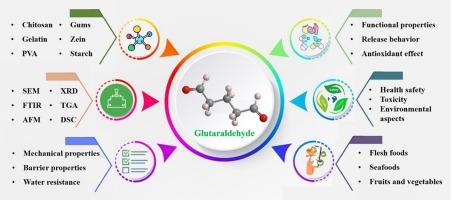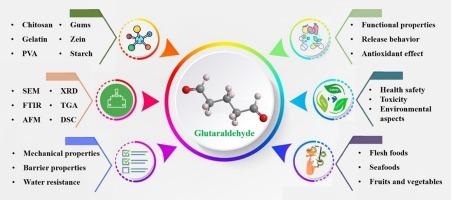Glutaraldehyde cross-linking for improving the techno-functional properties of biopolymeric food packaging films; a comprehensive review
IF 9.8
1区 农林科学
Q1 CHEMISTRY, APPLIED
引用次数: 0
Abstract
Biodegradable and/or edible films made from polysaccharides and proteins have gained attention for their potential to replace some traditional packaging materials in the food industry due to their abundance, biodegradability, and nutritional value. Glutaraldehyde (GLA), rapidly reacts with free deprotonated ε-amino groups in proteins, leading to crosslinking (CL) reactions. This review delves into the chemistry of GLA and explores the various biopolymeric food packaging materials crosslinked by GLA. Furthermore, it summarizes recent applications of active and intelligent food packaging based on GLA-CL of biopolymers for food preservation. The comprehensive enhancement of biopolymeric films through GLACL is evident, with the impact on their properties depending on the concentration of GLA and reaction state. GLACL with biopolymer molecules enhances the cohesion of the polymer network, with physical and chemical covalent CL being the primary phenomena. Notably, biopolymeric food packaging films/coatings fabricated by GLACL have proven highly effectiveness in preserving fresh foods.


戊二醛交联改善生物高分子食品包装膜技术功能性能全面回顾
由多糖和蛋白质制成的可生物降解和/或可食用薄膜因其丰富、可生物降解性和营养价值而具有取代食品工业中某些传统包装材料的潜力而受到关注。戊二醛(GLA)与蛋白质中游离去质子化的ε-氨基迅速反应,导致交联反应(CL)。本文综述了GLA的化学性质,并对GLA交联的各种生物高分子食品包装材料进行了探讨。综述了基于生物聚合物GLA-CL的活性食品包装和智能食品包装在食品保鲜中的最新应用。GLACL对生物聚合物膜的综合增强作用是明显的,其性能的影响取决于GLA的浓度和反应状态。GLACL与生物聚合物分子的结合增强了聚合物网络的内聚性,以物理和化学共价CL为主要现象。值得注意的是,GLACL制造的生物聚合物食品包装薄膜/涂层在保存新鲜食品方面已被证明是非常有效的。
本文章由计算机程序翻译,如有差异,请以英文原文为准。
求助全文
约1分钟内获得全文
求助全文
来源期刊

Food Chemistry
工程技术-食品科技
CiteScore
16.30
自引率
10.20%
发文量
3130
审稿时长
122 days
期刊介绍:
Food Chemistry publishes original research papers dealing with the advancement of the chemistry and biochemistry of foods or the analytical methods/ approach used. All papers should focus on the novelty of the research carried out.
 求助内容:
求助内容: 应助结果提醒方式:
应助结果提醒方式:


